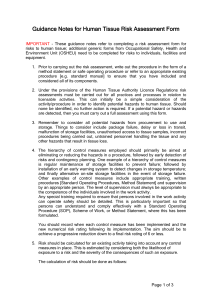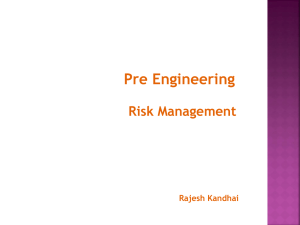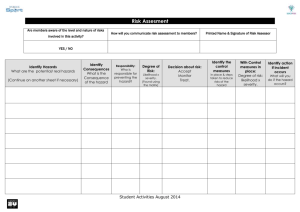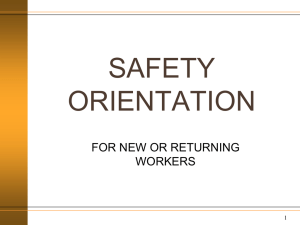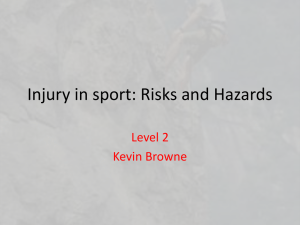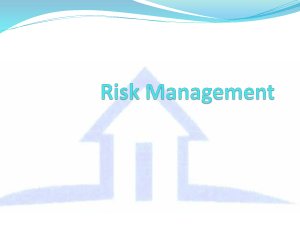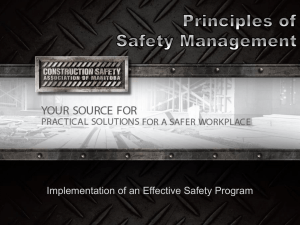HIRARC: Hazard Identification, Risk Assessment & Control
advertisement
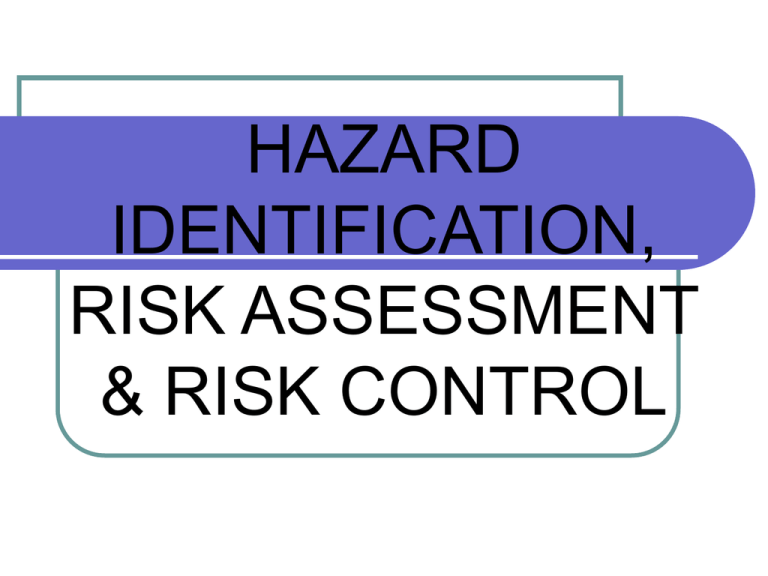
HAZARD IDENTIFICATION, RISK ASSESSMENT & RISK CONTROL OBJECTIVE To identify types of Hazard in work area To make Risk Assessments To suggest Risk Controls to Organization To implementing Risk Controls To review Risk Controls HIRARC -Planning & Implementation LEGAL ACCIDENT & NEAR MISSES FEEDBACK & COMPLAIN INSPECTION & AUDIT HIRARC SOP INTERNAL POLICY AUDIT ERP SAFETY COMMITTEE TRANING MANAGEMENT PROGRAM OSH-MS (MS 1722:2003) Key Elements Policy Organizing Planning And Implementation Measuring Performance Action for Improvement Why We Need OSH-MS Our Organization to be No. 1 Increase “Return of Investment” - employees, money , time….. Safe work place How To Start Organization should have vision Commitment from management - right people - resource - time How To Start Should have internal audit Management committee to review reports External audit Specific organization policy- hazard specific Employee’s participation - meeting, training Safety as basic training Why conduct a risk assessment Human factors–save life, stop workplace injures, illnesses and increase staff morale. Legal factors–meet legislative requirements, OHS&W and WorkCover. Financial factors–decrease the risk of prosecution and fines incurred, lower WorkCoverlevies, reduce absenteeism, increase potential for gaining shareholders and increase productivity. Hazard Management Process Identify the hazards Assess the risks Evaluate risks Control the risks Monitor and review Introduction to HIRARC Principles used in workplace to manage safety and health. Section 15 (2)(a) of OSHA 1994: which reads “ the provision and maintenance of plants and systems of work that are,so far as is practicable, safe and without risks to health” Definition Hazard A source or a situation with a potential for harm to humans, property and damage of environment or a combination of these. Danger Relative exposure to hazard. Risk A combination of likelihood of occurrence and severity of injury or damage. Overview Of HIRARC Definition of Hazards Classification of Hazards Potential sources of Hazards Basic components of Risk Management The Process of Risk Management Classify Activities (Work, Product, Services) Identify Hazard Assess The Risk Risk Control Review Risk Control Classification & Potential Sources of Hazards Classification Example of Hazards Mechanical - Sharp points & edges, overload. Electrical - Insulation damaged or cover broken Biological - Exposed, airborne/blood borne microorganism. Chemical - Expose to carcinogens chemical Ergonomics - Expose to unnatural postures Psychological- Stress or violent at workplace. WORK ENVIRONMENT Adequate Access Refers to adequate access to, from and within the workplace Air Conditioning Refers to uncontaminated air in the work space Confined Spaces Means enclosed work space where people do not normally work (defined in standards) Temperature Extremes: a) Heat This includes contact with hot objects, hyperthermia, fire (Not explosions) b) Cold This includes contact with cold objects and hypothermia Lighting Refers to adequate illumination for the particular work being done Mental Stress Includes bullying, workplace violence, shift work, excessive work loads Dehydration Adequate water supply for the individuals while working ENERGY Electrical Includes contact with exposed wires and contact with high voltage Gravity Includes falls, trips and slips of persons as well as objects falling, working at heights Kinetic Energy: a) The body hitting objects Hitting objects with part of the body b) Hit by moving objects Being hit by moving objects but excluding falling objects c) Explosion An explosion may also include heat as a hazard d) Penetrating objects This includes all objects that can penetrate including needles Vibration Includes vibration to parts or to the whole body Acoustic/Noise Includes exposure to single, sudden sound or long term exposure Pressure Pressure in hydraulic and pneumatic systems BIOLOGICAL Biological /Microbiological Includes bacterial, fungal, viral, parasitic or human/animal tissue/fluids blood products MECHANICAL Vehicles Being caught between, struck by or against vehicles (includes fork lifts) Mobile and Fixed Plant Being caught between, struck by or against plant (defined in legislation) Powered Equipment Includes electrical or fuel powered equipment, tools and appliances Non-Powered Equipment Includes non-powered hand tools, appliances and equipment CHEMICAL Flammable Refers to chemicals which burn Corrosive Refers to chemicals which will corrode tissue or metals Toxic Refers to chemicals which will poison a worker Oxidizers Refers to chemicals which will provide oxygen to a fire, or react readily Compressed Gases Refers to gases which under high pressure Hazard Identification To keep workplace safe and healthy. -employers should make sure there are no hazards to which employees could be exposed. Employers should look for hazards in advance as part of their risk management plan to prevent potential hazards. Actions & Recommendations All related statements should be made With no cost restrains Should be reviewed every 4 months Need management support Risk Assessment Is the process of evaluating the risk to safety & health from hazards at work Types - Qualitative - Semi-quantitative - Quantitative How To Assess Risk 1) Look for the Hazards 2) Decide who might be harmed & how 3) Evaluate the risk and check what is done to prevent it from happening • 4) Record finding • 5) Review assessment and revise it if necessary Types of Risk Assessment • • • • Qualitative - (Use Risk Matrix) -table scales for likelihood and severity Fatality Major injuries Minor injuries First aid or near misses Types of Risk Assessment Based on statistic Likelihood Very likely Likely Unlikely Highly Unlikely Qualitative Risk Table Likelihood Severity V/Likely Likely Unlikely H/Unlikely Fatality High High High Medium Major Injuries Minor Injuries High High Medium Medium High Medium Medium Low Medium Medium Low Low First Aid/ N/misses Semi-Quantitative Risk Assessment Severity Categories 1. First Aid 2. Less than 4 days M/C 3. More than 4 days M/C 4. Fatality & Permanent Disability Semi-Quantitative Risk Assessment Likelihood Occurrence 1. Yearly 2. Monthly 3. Weekly 4. Daily Semi-Quantitative Risk Table LIKELIHOOD S E V E R I T y Yearly Monthly Weekly Daily 1 2 3 4 First Aid 1 1 2 3 4 < 4 Days MC 2 2 4 6 8 > 4 Days MC 3 3 6 9 12 Fatality & Permanent Disability 4 4 8 12 16 Quantitative Risk Assessment In cases where hazards are numerous and complex eg; Chemical process plant Should have Job Safety Analysis (JSA) - describe job in less than 10 steps - List things that can go wrong - eg; Changing a Car Wheel Actions & Recommendations ELEliminate SLSubstitute ISIsolation ECEngineering Control AC Administration Control PPEPersonal Protection Equipment Actions & Recommendations Eg; EL - stop work, cover hazard… SL - use other route, other material.. IS - put up temporary barrier,… EC - construct permanent wall,.. AC - put up notice, job rotation,… PPE - gloves, respirator,…… Thank You
